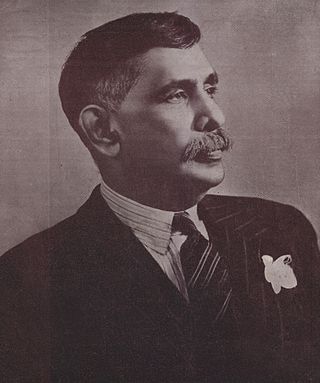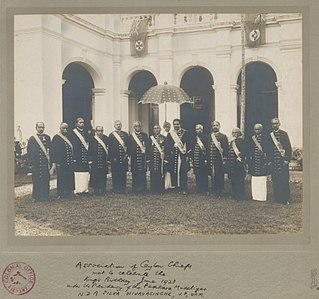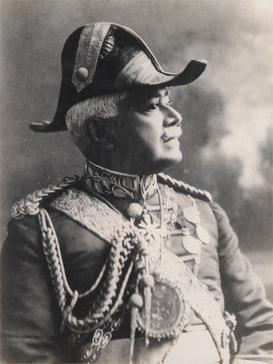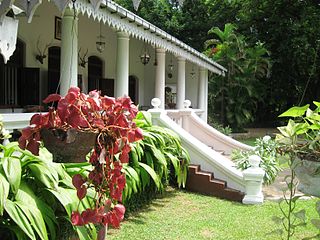Related Research Articles

Don Stephen Senanayake was a Ceylonese statesman. He was the first Prime Minister of Ceylon having emerged as the leader of the Sri Lankan independence movement that led to the establishment of self-rule in Ceylon. He is considered as the "Father of the Nation".

Solomon West Ridgeway Dias Bandaranaike, often referred to by his initials as S. W. R. D. or S. W. R. D. Bandaranaike and known by the Sri Lankan people as "The Silver Bell of Asia", was the fourth Prime Minister of the Dominion of Ceylon, serving from 1956 until his assassination in 1959, causing him to die in office. The founder of the left-wing and Sinhalese nationalist Sri Lanka Freedom Party, his tenure saw the country's first left-wing reforms.

Dudley Shelton Senanayake, was a Sri Lankan statesman who served as Prime Minister of Ceylon from 1952 to 1953, in 1960 and from 1965 to 1970 and Leader of the Opposition from 1960 to 1964. Senanayake's tenures as prime minister were associated with democratic socialist policies focused on agricultural and educational reforms with a pro-western alignment.

General Sir John Lionel Kotelawala was a Sri Lankan statesman, who served as the 3rd Prime Minister of Ceylon from 1953 to 1956.

Mudaliyar was a Ceylonese colonial title during Portuguese and British rule of the island. Stemming from the native headman system, the title was usually hereditary, made to wealthy influential families loyal to the British Crown.
Fredrick Richard Senanayake was a Ceylonesen lawyer and independence activist. A leading member of the Sri Lankan independence movement, he was an elected member of the Colombo Municipal Council. He was the principal supporter of the early political career of his younger brother D. S. Senanayake, who would go on to lead Sri Lanka's independence movement, becoming the first Prime Minister of independent Sri Lanka in 1947.

Sir Solomon Dias Abeywickrema Jayatilleke Senewiratna Rajakumaruna Kadukeralu Bandaranaike, was a Ceylonese colonial-era headmen. He was appointed as Head Mudaliyar and the aide-de-camp to the British Governor of Ceylon, therefore he was one of the most powerful personalities in British colonial Ceylon.

Sir Edwin Aloysius Perera Wijeyeratne, known as Edwin Wijeyeratne, was a Sri Lankan lawyer, politician, diplomat, and one of the founding members of the Ceylon National Congress and the United National Party. He was a Senator and Minister of Home Affairs and Rural Development in the cabinet of D. S. Senanayake. He thereafter he served as Ceylonese High Commissioner to the United Kingdom and Ceylonese High Commissioner to India

Walauwa or walawwa is the name given to a feudal/colonial manor house in Sri Lanka of a native headmen. It also refers to the feudal social systems that existed during the colonial era.

Don Richard Wijewardena was a Sri Lankan press baron who was involved in the Sri Lankan independence movement. A successful entrepreneur, he established Lake House newspapers and played a significant role in the independence movement.
Justin Kotelawala, CBE, JP was a Sri Lankan businessman and Senator. He was the former Chairman of the Ceylinco Group.

Deshamanya Edward Lionel Senanayake was a Sri Lankan politician belonging to the United National Party. He was the 12th Speaker of the Sri Lankan Parliament. Senanayake was the Governor of North Central Province and Central Province of Sri Lanka. He was elected to the Sri Lankan Parliament from Mahanuwara in Kandy.

Horagolla Walauwa is a large bungalow in Atthanagalla, Western Province, Sri Lanka.

Mudaliyar Don Spater Senanayake (1847–1907) was a Ceylonese, an entrepreneur and philanthropist. He was a successful graphite mine owner and was given the titular title of Mudaliyar for social service by the British colonial administration. He is the father of D. S. Senanayake, the first Prime Minister of Sri Lanka.

The Senanayake family is a Sri Lankan family that is prominent in enterprise and politics. Along with many members who have been successful politician across generations, the family includes two Prime Ministers of Sri Lanka.
Mudaliyar Don Charles Gemoris Attygalle was a Ceylonese, an entrepreneur and mine owner. He was a successful graphite mine owner and was given the titular title of Mudaliyar for social service by the British Governor of Ceylon. Through the marriage of his daughters the Senanayake family and the Jayewardene family were connected and played a major part in the Sri Lankan independence movement and in the post independence politics, foundered in part by the wealth he had accumulated.
The Jayewardene family is a Sri Lankan family that is prominent in law and politics. Along with many members who have been successful politician across generations, the family includes President and Prime Ministers of Sri Lanka.
The murder of Francis Dixon Attygalle took place on 5 December 1906, after he was shot in the abdomen and later succumbed to his injuries in hospital. The murder became Ceylon's first sensational trial, which lay blame on Attygalle's brother-in-law John Kotelawala Sr, who committed suicide in jail before the verdict was given.
Alice Elisabeth Kotelawala, CBE was a Ceylonese businesswoman and philanthropist. She was the mother of Sir John Kotelawala, third Prime Minister of Ceylon.
References
- ↑ Tribute to the last Tusker of Botale Walauwa, the great Gamini
- ↑ Nobodies to Somebodies: The Rise of the Colonial Bourgeoisie in Sri Lanka, Kumari Jayawardena, pp. 192-3 & 267 (Zed) ISBN 9781842772287
- ↑ "Gazette". The Gazette of the Democratic Socialist Republic of Sri Lanka . 1096. 3 September 1999.